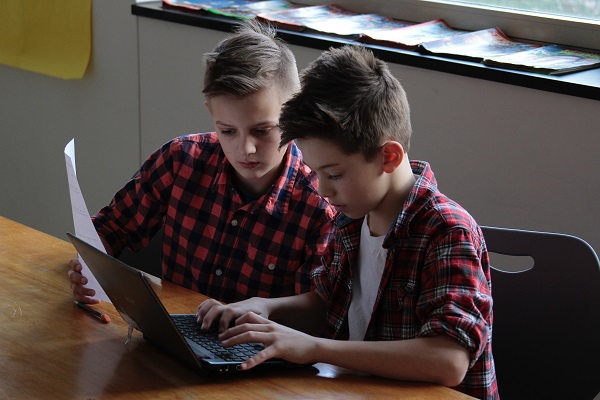
Quaker Valley 100 Days project teaches empathy and mindfulness
Photo above: Quaker Valley Middle School students Ben Henry, left, and Charlie Volk working on their 100 Days project. Photo by Noah Leathers
Sixth-grade students at Quaker Valley Middle School aren’t quite ready to change the world – but they’re off to a good start. Their 100 Days class project encourages the kids to make positive improvements in their school and community.
The project evolved after the students – like many social studies classes across the country – discussed and closely followed the recent presidential election, says Brian Wolovich, a math teacher at the school.
“The debates and messaging during the election were so terribly negative, and our country’s political divisions are deep right now,” he says. “We were searching for an active, positive way to move forward with our class discussions.”
Wolovich has been involved in a pilot program at Carnegie Mellon University’s CREATE Lab called The Fluency Project, where educators and researchers are considering the intersections of data, technology, inquiry, advocacy and case-making.
“The Sprout Fund’s 100 Days of US campaign inspired us to pose a similar challenge for our students to apply the Fluency Project framework to empower students to create and implement their own 100 Days plan to improve their community,” he says.
A goal of the project is to enable students to influence change, says Wolovich, who collaborated with other sixth-grade teachers – Karen Smearman (social studies) and Kerry Peters (English language arts) – as well middle school principal Anthony Mooney.
“Ultimately that student empowerment can help them build self-esteem and positivity,” he says.
Students have embraced the project, organizers say. Along the way, they are learning about doing research, writing mission statements, fundraising, and gaining approval from school supervisors – and even government officials.
Some efforts are on a smaller, more personal scale. Student John Lytle says his project is “to make people happy by doing random acts of kindness each day of the week.”

Larger group endeavors include learning about and supporting neighbors in need. For example, Adam Renner and a team of students chose to help Project Linus, a nonprofit organization that collects handmade blankets and afghans for children in hospitals and shelters.
“My teacher and mentor, Mrs. Smearman, shared a story about her son’s experience in a hospital and how happy he was to receive a Project Linus blanket, which made his stay easier,” Adam says. “This made me feel compelled to play a part in making and donating blankets for this organization and sick kids in Pennsylvania.”
Their biggest challenge, he says, is getting material to make the blankets.
“Not only do we need to collect or fund-raise money, but the materials we use must be new to prevent any germs entering the hospitals,” Adam says.
Susanna Getty and Thomas Ellis represent another student team, which selected Light of Life Rescue Mission in Pittsburgh as their 100 Days project. Their goal is to prepare and deliver food to the mission. The process includes choosing a recipe, talking to the mission kitchen staff, and discussing transportation with their principal. They also need to work with their teacher in Family Consumer Science about cooking the meals in her classroom after school.
Students Charlie Volk and Ben Henry are working together to build a basketball and multi-use court in their neighborhood that could be available for kids and adults.
“I pass the desired location almost every day, and it is a rarely used area that can be put to much better use,” they wrote in their action plan. “This will benefit current and future athletes throughout the area and will inspire more kids to get outside and play sports.”
Their challenges include getting board approval, neighbor approval and raising money for the project through donations and grants.
Miralhi Taylor-Martin and Kyle Hammond represent eight students whose plan is to purchase and install refillable water bottle stations at their school to reduce waste. They hope to raise money through various fundraisers.
“We saw all the plastic that was being wasted, and we decided to dig a little deeper. It turns out there is a huge amount of plastic littering the ocean from water bottles; we found that pretty appalling and we knew we needed to make a difference,” they wrote.
They see a long-term benefit in their project and others: “Young people make up a lot of our population, and we are the future. If we learn to do good things that benefit our city, then when we’re older, it will be natural.”
Wolovich says the teachers hope their 100 Days project helps students to develop skills and dispositions that can influence them to see service to others as a part of who they are as developing individuals.
“There are awesome successes and fantastic failures taking place with the project,” he says. “By lifting up the learning opportunities within both, we hope to support our students to continue taking responsible risks with their learning and inquiry. We celebrate the journey and destination.”